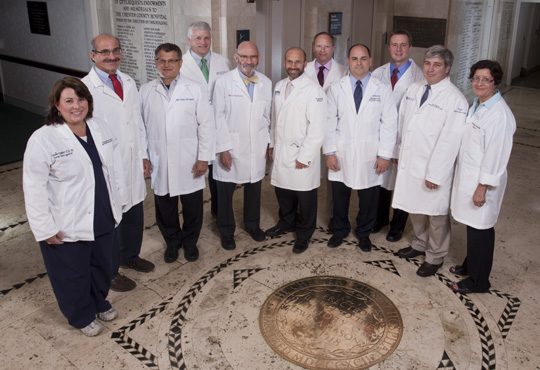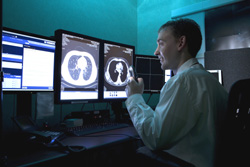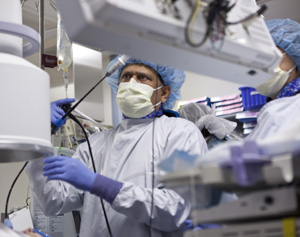
A multidisciplinary team of experts worked together at The Chester County Hospital to develop and launch the new lung screening program. Not pictured Rajesh J. Patel, MD.
Published: Synapse 2012, Vol. 2
The American Lung Association reported 303 cases of lung cancer in Chester County in 2009.* According to estimates from the National Cancer Institute, there will be 226,160 new cases of lung cancer in the United States this year and 160,340 deaths from the disease.
A cancer diagnosis is frightening. Lung cancer, in particular, can be worrisome. But it doesn't have to be. Lung cancer can be curable if found in its earliest, most treatable stages. The challenge is that lung cancer has always been very difficult to detect before the disease has progressed to the point where treatment options are limited and a cure not very likely. However, recent advances in early detection are changing the way lung cancer is diagnosed, giving doctors a better opportunity to treat the condition, and saving more lives.

Jeffrey Gramp, MD, Radiology, reviews the low dose spiral CT scan of a lung patient.
The Chester County Hospital and Health System has launched a new lung cancer screening program to help protect the individuals in our community who are most at risk for the disease. The program is built upon the findings of a recent National Lung Screening Trial (NLST), which determined that lung cancer deaths can be reduced by screening for the disease using low-dose computed tomography (CT). Lung cancer deaths dropped by 20 percent in study participants who underwent a CT scan compared to those screened solely by chest x-rays.
At Chester County, a multidisciplinary team of experts in thoracic surgery, pulmonary medicine, medical oncology, radiation oncology, pathology, and radiology worked together to develop and launch the new screening program. Their ongoing goal is three-fold:
- to find lung cancer earlier through the use of the latest technology
- to provide the best and most advanced treatment options available
- to educate high-risk individuals about the disease.
"Historically, the mortality rates for lung cancer have been staggeringly high because the disease is usually so far along when found. Unfortunately, there are no obvious symptoms until the disease is so advanced that treatment options are not often successful. Even then, symptoms are easily mistaken for signs of other respiratory conditions or illnesses," explains Michael R. Costello, MD, Hematology/Oncology. "Our new screening program gives us the ability to find lung cancer at a much earlier stage in high-risk patients who otherwise may have waited too long. If we can find these cancers earlier we can offer patients the hope of curing them."

To help diagnose lung cancer and plan appropriate treatment, Rajesh j. Patel, MD, Pulmonology, uses a high-tech, minimally invasive procedure called Electromagnetic Navigation Bronchoscopy (ENB).
The program targets smokers, specifically long-term smokers, because they are most at risk for lung cancer. "The facts are rather daunting. Smoking is the number one cause of lung cancer, and lung cancer is the number one cause of cancer-related death in the United States and worldwide," says Robert Satriale, MD, Pulmonary Disease. "Smokers may face even greater odds of developing lung cancer when other risks factors are involved, such as exposure to elements like asbestos or radon, a family history, or a diagnosis of COPD (chronic obstructive pulmonary disease) or pulmonary fibrosis."
The screening process begins with a safe, low dose spiral CT scan, which generates a series of detailed cross-sectional images of the lungs to create a three-dimensional image.
The scan is used as a preventive and diagnostic tool in much the same way as mammograms and colonoscopies are used for breast cancer and colon cancers. Many smokers going through the screening process will have no evidence of lung cancer, and all abnormal findings will not end up being diagnosed as cancer.
If the scan does detect a concern, the program follows through with the diagnostic and treatment resources needed to achieve the most favorable outcomes. In addition, the full scope of the Lung Cancer Program includes a smoking cessation program that combines education, behavior modification and relaxation techniques to help people quit smoking.
To help diagnose lung cancer and plan appropriate treatment, a high-tech, minimally invasive procedure called Electromagnetic Navigation Bronchoscopy (ENB) is often implemented. "ENB applies GPS-like navigation technology to guide us deep into the lungs," explains Rajesh J. Patel, MD, Pulmonary Disease. "It allows us to biopsy lesions that are inaccessible through traditional bronchoscopy and might otherwise require invasive surgery for diagnostic testing and potential treatment."
The Chester County Hospital is the only hospital in the southeastern Pennsylvania suburbs that has the advanced ENB technology.
According to Scott Saul, MD, Pathology, each lung cancer biopsy has its own story to tell and contains specific information that influences the choice of treatment. "The precision of testing procedures have evolved exponentially in recent years," he notes. "Certain therapies will work successfully only for very specific lung cancer types. The subtle distinctions we are able to make as we test each specimen point to the treatment best suited for each patient."
"Right now lung cancer screening is not covered by insurance, but it should be and probably will be. We are keeping the cost as low as possible and help is available if needed," adds Michael Costello, Hematology/Oncology. "Of course, the ideal way to deal with lung cancer would be to prevent it, but the next best approach is to catch it early. Our program is here to provide whatever steps are necessary to protect those most vulnerable to this far too often fatal disease."
By Beth L. Eburn
Photos by Rick Davis
*Statistical cancer data typically takes two to three years to analyze and categorize, which is why we shared a 2009 stat.
Lung Cancer Screening
By prescribed appointment only
Please talk to your doctor about whether you meet the specific screening criteria based on your age, health history, smoking habit or environmental exposures. A physician prescription is required. The screening includes: low-dose spiral CT scan; CT scan reading by a board-certified Penn radiologist; results sent to your primary care physician; and a fast-track appointment with a pulmonologist (if appropriate). The fee for the lung cancer screening through the program is $129, and flexible spending funds may be used. Call 610.738.2300 to learn more.
Stop Smoking Now! Series
Numerous sessions throughout the year
A FREE seven-week cessation program offered regularly throughout the year, Stop Smoking Now! helps you develop a plan to become a nonsmoker. Through a combination of education, behavior modification, and relaxation techniques, this program teaches you the tools you need to take this important step. The class meets weekly to help identify your smoking triggers and deal with your withdrawal symptoms. Over-the-counter Nicotine Replacement Therapy (NRT) is available at no charge. This program is currently free to the community. Call 610.738.2300 to enroll.
Better Breathers Support Group
Meets every 1st Tuesday at 2:30 pm
The Better Breathers Support Group is a FREE program organized by the Pulmonary Rehabilitation Program for those coping with chronic lung disease. Striving to build a positive outlook, this program provides participants with meaningful information, support and camaraderie. Presentations by healthcare professionals are scheduled monthly. Call 610.738.2410 to learn more.
219,000
The number of cigarettes smoked at one pack a day for 30 years
The people who can benefit most from the lung cancer screening are smokers between the ages of 55-74 who have smoked at least one pack of cigarettes a day for 30 years or who have quit smoking within the last 15 years, as well as smokers age 50 years or older who have smoked at least one pack of cigarettes a day for 20 years AND have an additional risk factor or a personal or family history of cancers.